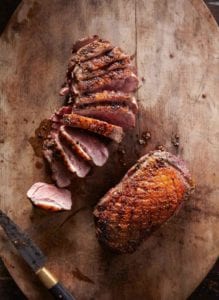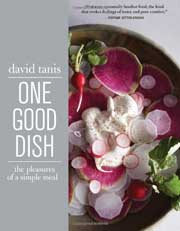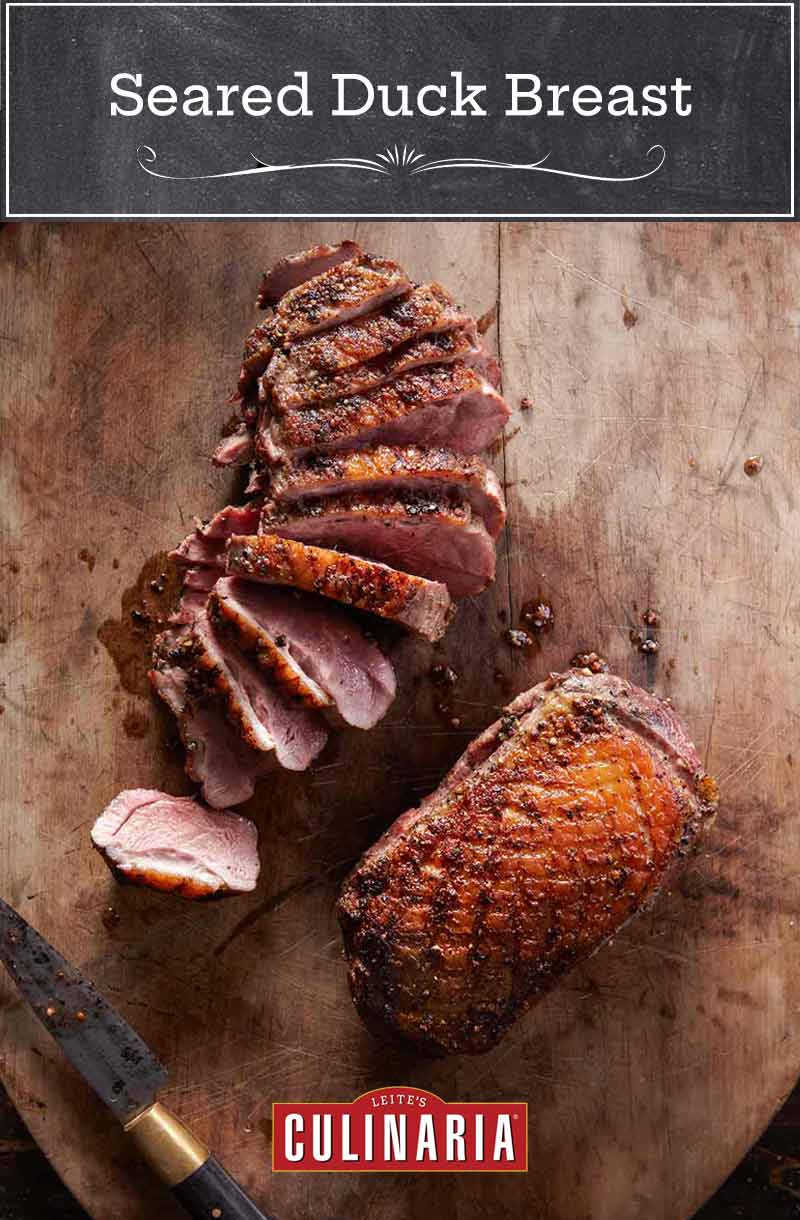
Chef David Tanis took inspiration for this simple seared duck breast from classic steak au poivre, which is simply rubbed with a paste of black peppercorns and garlic that is pan seared to perfection to impart the duck a magnificently crisp skin and a rosy medium-rare doneness.. The foolproof method below outlines exactly how.–Renee Schettler Rossi
What Is Gremolata?
The lovely little parsley situation in this recipe casually stretches the definition of gremolata from the classic garnish of minced parsley, lemon zest, and garlic to a stately little salad of whole parsley leaves and a lemon vinaigrette with the edge of garlic. The minced rendition is traditionally sprinkled atop osso buco (braised veal shanks) as a means to effectively slash the dish’s richness from ridiculously indulgent to really quite tolerable—and quite enjoyable—levels. It’s a trick that also works well with similarly rich dishes such as duck, amply marbled steak, fish panfried in butter, and the like. This salad does exactly the same. Groovy. Although moms, you may want to make certain it’s on the side and not touching the duck breast. Almost every kid we know loves duck breast, though parsley not so much.

Seared Duck Breast
Ingredients
For the duck
- 1 1 lb Muscovy duck breast
- 1 teaspoon salt
- 4 garlic cloves, smashed to a paste with a little salt
- 1 tablespoon coarsely crushed peppercorns
For the parsley salad
- 1 large bunch flat-leaf parsley leaves
- 2 teaspoons fresh lemon juice
- Salt, to taste
- Freshly ground black pepper, to taste
- 1 small garlic clove, minced
- 2 tablespoons extra-virgin olive oil
- Chunk Parmigiano-Reggiano cheese, (optional)
Instructions
Make the duck
- Using a sharp knife, remove the tenderloin from the underside of the duck breast and reserve for another use. Trim any ragged bits or gristle from the underside of the duck, and then turn the breast over and trim any excess fat from the edges. Pat the duck completely dry with paper towels.
- Place the duck, skin side up, on a cutting board. Score the skin with the tip of the knife by making shallow diagonal cuts, 1/2 inch apart, in one direction and then repeating in the other direction, creating a diamond pattern. Season both sides of the duck (that is, the skin side and the meat side) with the salt, then massage with the garlic paste (again on both sides), and then press the crushed peppercorns evenly onto the surface (again on both sides). Put the duck on a platter and set aside for at least 1 hour at room temperature. (You can instead cover and refrigerate the duck overnight; bring to room temperature before cooking.)
- Heat a cast-iron skillet over medium-high heat until hot but not smoking. Carefully add the duck breast, skin side down, and let it sizzle for several minutes. Using tongs, check to see that the skin is not browning too quickly and that the garlic is not burning, and if necessary, reduce the heat. Be careful; the duck breast will render a fair amount of hot fat. Cook until the duck skin is golden and crisp, 6 or 7 minutes. Turn the duck breast over and cook for 2 minutes more. Transfer the duck to a carving board and let rest for at least 10 minutes. Reserve the rendered duck fat in the skillet, allowing it to cool to room temperature and then straining it into a jar and refrigerating it for future use.
Make the parsley salad
- Pick the parsley leaves from the stems—you want about 2 loosely packed cups. Wash and gently dry with a clean towel.
- In a small bowl, whisk together the lemon juice, salt and pepper to taste, garlic, and oil.
- At the very last moment before dinner, turn the parsley leaves into a serving dish, add a sprinkle of salt, and then gently toss with the dressing to coat lightly. Serve in a fluffy pile and garnish with shavings of Parmigiano, if desired.
Serve the peppery duck breast
- Cut the duck at an angle into 1/4-inch-thick slices and arrange on a platter. If desired, top the duck with a fluffy pile of parsley salad. Serve immediately.

Explore More with AI
Nutrition
Nutrition information is automatically calculated, so should only be used as an approximation.
Recipe Testers’ Reviews
I LOVED this recipe. The marinade was simple and very flavorful. The resulting duck was tender and well flavored.
I initially thought the garlic may overpower the flavor of the meat but it was delicately there. As a complement to the duck, the parsley salad recipe fits the bill nicely. I loved the simple dressing and I would make it again. I would have preferred a few other greens mixed with the parsley, as I don’t really like the taste of a salad made of entirely parsley, although I really liked the simple dressing. The dressing mixed very well with the juices of the duck. Bottom line: I think I’ll make duck this way again and again.
Duck is not normally on the weeknight menu at my house but this recipe was simple enough for a Thursday night treat. Duck meat really sings on its own, so I appreciated the simple flavors in this dish.
The cast-iron skillet adds a dose of homemade flavor and I couldn’t help but relish in the seasoning my pan was taking in as the duck fat simmered (duck really does release a lot of fat). I would recommend that after the duck hits the pan, you not walk away from the stove for even a second as there’s a fine line between perfectly cooked and overcooked duck. I’d also add more peppercorns and salt because it wasn’t memorably peppery.
The resulting duck fat from the dish served as the perfect inspiration for duck fat fries, which we cooked up while the duck was resting. We served the fries alongside the duck with more of the parsley salad and some Parmesan. I liked the versatility of this salad and it would be easy to customize depending on your dish. Next time, I’ll likely add more garlic and more lemon, as it wasn’t as bold as I had expected. However, this is a taste-as-you-go recommendation, since everyone will have a different level of “Bam!” that they prefer.
I’ll keep this recipe on hand as a simple dressing for, well, pretty much anything. I used the leftover parsley salad on roasted butternut squash. It was a deliciously indulgent weeknight meal and a medium-bodied, dry red wine was the perfect accompaniment.
This seared duck recipe was the perfect centerpiece for a delicious meal of fall flavors. What a clever idea to turn this into a duck au poivre, just like the steak that we all know and love! I served the duck and the parsley salad alongside a warm farro salad with roasted fall vegetables and feta cheese. Such a tasty meal, it was hard for us not to “Mmmm” the whole time we were eating!
My only comment on the recipe is the garlic paste that you smear on the duck breasts. Because you’re cooking the duck on high heat in a cast-iron skillet, some of the garlic pieces were a bit crispy and burnt once I flipped the duck breast over. My recommendation would be to maybe put the garlic paste underneath the duck skin instead of on top of it; that way you still get the delicious garlicky flavor without it burning during the searing process.
Overall, the cooking times were right on, though, for a perfectly cooked duck breast with very crisp skin.
This was a very simple and tasty recipe. The duck was cooked to perfection and couldn’t be any more tender or juicy. It was also simple enough for a weeknight dinner. The salad nicely complemented the duck, as it was light and didn’t overpower the meat.
I never would’ve thought a salad made mostly of parsley leaves could actually be filled with taste yet look so elegant. Even as an appetizer stand-alone, this would’ve been fantastic.
I had to buy a whole duck to get duck breasts. Not the easiest task, and time-consuming, too, though having the rest of the animal was perfect for making duck stock. [Editor’s Note: And let’s not forget the rendered duck fat is perfect for potatoes, and the legs are lovely as a luscious confit…]














David this recipe is fantastic! The peppercorns and garlic add a nice touch of spice and flavor to the duck breast.
Thanks, Julia.
I bought this book a couple of months ago and quickly worked through a dozen of these recipes. The duck breast recipe here was absolutely fantastic. My wife (my personal Gordon Ramsey picky, honest critic) barely spoke as she chowed through it.
When she saw it marinating on the kitchen counter swathed in the crushed peppercorn (she is sensitive to spicy due to a gum condition) she was alarmed, but it was perfect. Accompanying the duck was the crispy potato galette also from his same book, as well as the parsley salad which, alas–we found rather underwhelming. The shaved Parmesan barely rescued it from BORing, but given the success of the other dishes, no one complained.
Of course, no Muscovy duck to be had at a price point here in Berkeley that I could live with, but a Pekin duck worked fine.
Added hint–use a high-sided skillet to avoid splatter and TENT your breast in foil while resting to retain heat.
Excellent, dontctallmechef. I agree that it’s an excellent book. Thanks for the heads-up about the salad and for the tip about using a high-sided skillet.